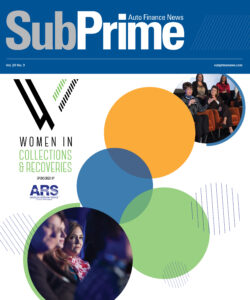Repossessions: What’s the Alternative?
SARASOTA, Fla. — In this difficult economy, more and more customers are struggling to make their buy-here, pay-here car payments. Repossessions are occurring at record levels as customers are simply surrendering their vehicles and walking away from the balance on their loan obligation.
A job loss or overextended credit means they just can't afford the payment any longer. Working with your customers by keeping them in the car, making their payments, may be the best solution available to keep your loan portfolio from experiencing significant charge offs.
Aside from the negative impact repossessions and charge offs have on the profitability of your business, why should a BHPH dealer be concerned about an increase in repossessions? Firstly, repossessions that lead to charge-offs reduce the size of your portfolio. Depending on the outstanding loan balance and the recovered loss you are able to recoup, the amount charged off can be significant.
In addition, a reduction in the size of your portfolio means reduced receivables and cash flow. Another concern that BHPH dealers need to consider is the impact that an increase in charge-offs will have on your ability to borrow against your loan portfolio or qualifying for additional capital you may need to fund or expand your business.
Statistics provided by Subprime Analytics at the 2009 National Alliance of Buy-Here, Pay-Here Dealers conference indicates that the average gross dollar loss before recoveries was $6,887.00 in 2008, compared with an average gross loss of $6,753 in 2007.
The average net dollar loss after recoveries was $5,157 in 2008 compared with $4,693 in 2007. The average default rate, which reflects the percentage of loans written off, was 28.43 percent in 2008 compared with 27.71 percent in 2007. The average gross dollar loss as a percentage of principal was 35.54 percent in 2008 compared with 37.32 percent in 2007. The average recovery rate as a percentage of principal charged off declined to 28 percent in 2008 from 30.60 percent in 2007.
One of the most important functions in processing your repossessions is maximizing recovered loss on the charged off account. Recovered loss represents an important source of "cash in" for a BHPH operation and minimizes loses against charge-offs.
Profitable BHPH dealers utilize a wide range of options to sell, assign a fair value, or dispose of the charged off vehicle. Maximizing proceeds from recovered loss is an important tactical step to minimize the cost of charge offs in a BHPH operation.
Calculations such as Collateral Recovery Rate are used by funding companies to determine the value of your loan portfolio. The CRR calculation takes into consideration the performance of your portfolio as it relates to principal payments, recovered loss, collection rates and gross charge-offs. This means that to qualify for capital in today's tough money market, and perhaps for many years to come, dealers will need to demonstrate how their loan portfolio has performed in order to qualify for the capital they need.
Take a moment to calculate your CRR percentage. To do this, divide principal payments plus all recoveries by principal payments plus total gross charge offs. The "sweet spot" for Collateral Recovery Rate is 75 to 80 percent. A number higher than 90 percent would indicate a low threshold for risk in your portfolio. A lower number would indicate a higher threshold for risk in your portfolio.
With a low CRR (70 to 75 percent), the portfolio would be deemed questionable as it relates to the vehicles being put on loan, the underwriting policies and the collections practices of the business. A CRR percentage of 70 percent and/or a charge-off rate of 30 percent or more would not likely be given consideration for loans against your portfolio.
So, there are financial reasons for keeping your customers in the car, and working with your customers so they can continue to make payments, and avoid repossessing vehicles and charging them off.
Another important reason for working with your customer is that by keeping them in the vehicle and making payments, a positive customer relationship it develops. By their nature, many BHPH customer are not good money managers and do not have any savings. When unforeseen expenses arise such as an unusually high electric bill, or being short on their pay check because of lost hours due to an illness, they are not prepared for the problem.
In many cases the customer has to make choices about what bills they can afford to pay. If you believe that most people are good people, and they want to do what is right, helping them through a difficult time by accepting a partial payment, or spreading the delinquent payment over the next two or three payments can create a tremendous amount of good will and serve to build positive customer relationships as well as repeat and referral business.
However, before your customers start to think that any excuse will get them a payment extension on a past due amount, you should establish a firm policy that requires all customers to provide verification to confirm why their payment was not made in full and on time. This verification should be provided before any discussion of a payment extension will be considered.
For example, the customer must be able to produce a bill to verify the higher than usual electric bill, or a paycheck stub to verify they were short paid due to loss of hours, or a receipt to verify the prescription medicine they bought for a sick child. In addition, all payment arrangements should be made in writing with specific details on dates and amounts agreed on to bring the account current.
This document should be signed by the customer and the dealer or manager and a copy given to the customer. It's also important for customers to understand that a payment arrangement is not automatic, and that they must provide proper verification to support the reason they cannot make their payment in full. You want your customers to understand that you will work with them if the problem is legitimate, and will provide a payment arrangement that is fair to them and reasonable for you in order to bring their account current.
"Recency" is a terminology that means how recent your customer has made a payment on their account. An account may be delinquent, but if a customer is making frequent payments on their account it's important to track the payment frequency separately from the delinquent amount.
If your dealer management software doesn't track and report recency, you are missing a valuable reporting tool for your BHPH business. In this economic climate, recency is an important measurement tool for the performance of your portfolio because it tracks delinquency in a manner that shows the customer's intention to pay, and effort to bring their account current.
Although there are many economic factors that are contributing to an increase in delinquency, repossessions and charge-offs, it would be a mistake not to examine your underwriting policies and procedures to make sure that your credit decisions are not contributing to the problem.
According to the NABD, the best performing dealers experienced an average portfolio delinquency rate of 11.75 percent in 2008. If your BHPH business is experiencing a higher than average delinquency rate, you may be creating your own problems.
Some of the most common underwriting mistakes include not matching the customer to the right vehicle and related deal structure when granting credit. Essentially, selling the customer the vehicle they want, instead of the one they can afford. Other mistakes include not running a credit report and not completing a risk assessment report prior to granting credit.
Understanding the customer's credit background and degree of credit impairment will add valuable perspective to your risk assessment and credit decisions. Another common mistake is not verifying the information provided by the buyer and co-buyer on the loan application. Verifying residence, employment and income information is a critical step prior to approving loans to credit challenged customers.
Another common mistake that can impact your repossession and charge-off results is allowing a large down payment to affect your credit decision instead of using it to make the deal structure better. This is particularly true during tax refund season. The down payment and the customer's loan qualification should be evaluated separately.
Today, technology such as starter-interrupt devices and GPS units have made locating or disabling a vehicle much easier than in previous years. However, installing a SID and/or GPS device on a vehicle should not be used as a reason to approve a loan application.
At best, SID and GPS devices are collection and recovery tools. If you make loan decisions based on being able to disable or locate the car if the loan goes into default, I can pretty much guarantee that you will experience an increase in repossessions and charge-offs as a result of not thoroughly evaluating the credit history and the risk associated with each loan approval.
So the bottom line is that working with your customers and keeping them in the vehicle making payments may be the best solution to maintaining a profitable bottom line in your business. In this difficult economy we are seeing an increase in delinquency, repossessions and charge-offs. The question you want to ask yourself is what can you do to protect your loan portfolio from suffering an increase in repossessions and charge offs?

 View The Latest Edition
View The Latest Edition

